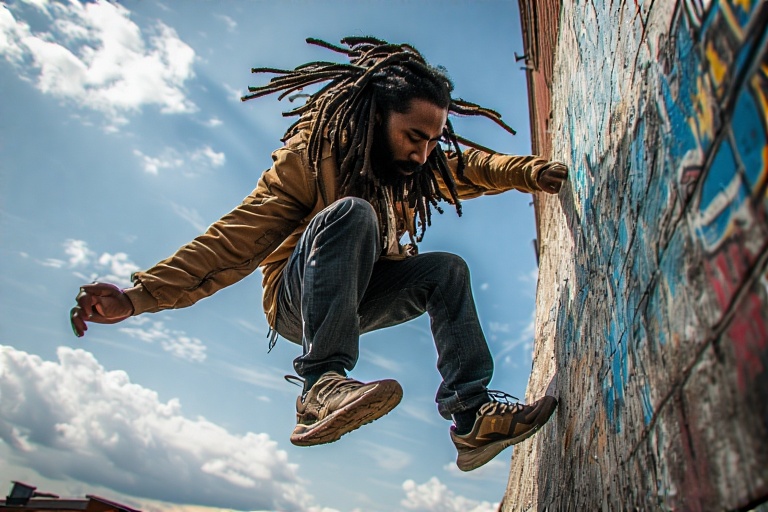Dreadhead parkour is the electrifying fusion of parkour—a discipline of navigating urban environments with speed, efficiency, and creativity—and the distinctive aesthetic of dreadlocks. Parkour itself is about overcoming obstacles, whether they’re physical barriers like walls and railings or mental hurdles like fear and doubt. Dreadhead parkour adds a layer of cultural flair, where practitioners, often referred to as “dreadhead traceurs,” use their unique style to stand out in the urban jungle. The term “dreadhead parkour” has gained traction on social platforms like X, where videos of dreadhead traceurs flipping, vaulting, and leaping through cityscapes have gone viral.
The essence of dreadhead parkour lies in its celebration of individuality. Dreadlocks, a hairstyle rooted in cultural significance, symbolize freedom, rebellion, and authenticity for many. When paired with parkour’s philosophy of limitless movement, dreadhead parkour becomes a powerful form of self-expression. It’s not just about the physical act of jumping or climbing; it’s about embodying a lifestyle that defies convention and embraces creativity.
The Origins of Dreadhead Parkour
While parkour as a discipline was formalized in France in the 1980s by founders like David Belle, dreadhead parkour emerged more recently as a subcultural phenomenon. The term began trending in online communities around 2015, particularly on platforms like Instagram and YouTube, where athletes with dreadlocks showcased their parkour skills. These dreadhead traceurs brought a fresh perspective, blending urban athleticism with a hairstyle that carries deep cultural roots, often associated with Rastafarianism, African heritage, and countercultural movements.
Dreadhead parkour gained momentum as a way for practitioners to differentiate themselves in a crowded parkour scene. The hairstyle became a visual marker, making dreadhead traceurs instantly recognizable in videos and live performances. Today, dreadhead parkour is a global movement, with communities in cities like Los Angeles, London, and Johannesburg, where traceurs gather to train, compete, and inspire each other.
Why Dreadhead Parkour Stands Out
Dreadhead parkour isn’t just about aesthetics; it’s about embodying a mindset. The combination of dreadlocks and parkour creates a striking visual contrast—flowing hair against the backdrop of concrete and steel. But beyond appearances, dreadhead parkour represents a fusion of physical discipline and cultural pride. Here’s why it’s capturing hearts worldwide:
- Cultural Identity: Dreadlocks carry historical and cultural significance, often tied to spirituality, resistance, and individuality. Dreadhead parkour celebrates this heritage while pushing physical boundaries.
- Community Connection: Dreadhead traceurs form tight-knit communities, sharing tips on training, hair care, and personal growth. These groups foster a sense of belonging and mutual support.
- Visual Appeal: The dynamic motion of dreadlocks during flips and jumps adds a cinematic quality to parkour performances, making dreadhead parkour a favorite for videographers and content creators.
- Inclusivity: Dreadhead parkour welcomes people from all backgrounds, uniting them through a shared passion for movement and self-expression.
Techniques and Training for Dreadhead Parkour
Mastering dreadhead parkour requires a combination of parkour fundamentals and adaptations to accommodate the unique challenges of dreadlocks. Here are some key techniques and training tips for aspiring dreadhead traceurs:
Core Parkour Skills
Dreadhead parkour builds on the foundational movements of parkour, including:
- Vaulting: Using hands to leap over obstacles like railings or low walls.
- Precision Jumps: Landing accurately on small surfaces, such as ledges or beams.
- Wall Runs: Scaling vertical surfaces to reach higher platforms.
- Flips and Spins: Adding flair with acrobatic moves like front flips or corkscrews.
Adapting for Dreadlocks
Dreadlocks can affect balance and aerodynamics, so dreadhead parkour practitioners often adjust their techniques:
- Hair Management: Many dreadhead traceurs tie their dreads back with a bandana or headwrap to prevent them from obstructing vision or getting caught during complex moves.
- Balance Awareness: The weight of dreadlocks can slightly shift a traceur’s center of gravity, requiring extra focus on core strength and stability.
- Maintenance: Regular hair care is crucial to keep dreadlocks healthy and manageable, especially after sweaty training sessions in urban environments.
Training Tips
- Start Small: Begin with basic movements like rolls and low vaults to build confidence and technique.
- Strength Conditioning: Focus on bodyweight exercises like pull-ups, squats, and planks to develop the strength needed for dreadhead parkour.
- Find a Community: Join local parkour groups or online forums to connect with other dreadhead traceurs for support and inspiration.
- Film Your Progress: Recording your sessions helps you analyze your form and share your dreadhead parkour journey with the world.
The Dreadhead Parkour Community
The dreadhead parkour community is a vibrant, supportive network of athletes who share a passion for movement and self-expression. On platforms like X, dreadhead traceurs post videos of their latest stunts, often set to hip-hop or reggae beats that complement the cultural vibe of dreadlocks. These communities host meetups, workshops, and competitions, where dreadhead parkour enthusiasts can learn from each other and push their limits.
One notable aspect of the dreadhead parkour community is its emphasis on inclusivity. Practitioners come from diverse backgrounds, united by their love for parkour and the shared experience of maintaining dreadlocks. Online forums and social media groups offer tips on everything from perfecting a backflip to caring for dreads in humid climates, creating a sense of camaraderie that transcends borders.
Challenges of Dreadhead Parkour
While dreadhead parkour is exhilarating, it comes with unique challenges:
- Physical Demands: Parkour is inherently demanding, requiring strength, agility, and endurance. Dreadhead traceurs must maintain peak physical condition to perform at their best.
- Hair Maintenance: Dreadlocks require regular care to prevent buildup or damage, especially when exposed to dust and sweat during outdoor training.
- Public Perception: Some dreadhead traceurs face stereotypes or judgment due to their hairstyle, but the community uses these challenges as fuel for empowerment and self-expression.
Despite these hurdles, dreadhead parkour continues to grow, with traceurs overcoming obstacles both literal and figurative through their dedication to the craft.
How to Get Started with Dreadhead Parkour
Ready to dive into dreadhead parkour? Here’s a step-by-step guide to begin your journey:
- Learn the Basics: Study parkour fundamentals through online tutorials or local classes. Focus on safety and proper form to avoid injuries.
- Build Strength: Incorporate strength training and flexibility exercises into your routine to prepare your body for the demands of dreadhead parkour.
- Care for Your Dreads: Invest in quality hair products and learn proper maintenance techniques to keep your dreadlocks healthy and stylish.
- Connect with Others: Join dreadhead parkour groups on X or local meetups to find mentors and training partners.
- Practice Consistently: Set small, achievable goals and practice regularly to build skills and confidence in dreadhead parkour.
The Future of Dreadhead Parkour
As dreadhead parkour continues to gain popularity, its future looks bright. The rise of social media has made it easier for dreadhead traceurs to share their skills, inspiring a new generation of athletes. Events like parkour jams and freestyle competitions are increasingly featuring dreadhead parkour categories, showcasing the unique blend of style and athleticism.
Moreover, dreadhead parkour is becoming a platform for social change. Many traceurs use their visibility to promote messages of inclusivity, cultural pride, and environmental awareness, encouraging others to embrace their individuality while respecting the world around them. As the movement grows, dreadhead parkour has the potential to redefine how we view urban sports and cultural expression.
Conclusion
Dreadhead parkour is more than a sport—it’s a celebration of movement, culture, and individuality. By combining the fluid, dynamic art of parkour with the bold aesthetic of dreadlocks, dreadhead traceurs are carving out a unique space in the world of urban athletics. Whether you’re drawn to the physical challenge, the cultural significance, or the vibrant community, dreadhead parkour offers something for everyone. So, lace up your shoes, tie back your dreads, and take the leap into this exhilarating world of self-expression and agility.
FAQs
1. What is dreadhead parkour?
Dreadhead parkour is a subculture that combines the athletic discipline of parkour with the cultural and aesthetic significance of dreadlocks, creating a unique blend of movement and style.
2. Do I need dreadlocks to practice dreadhead parkour?
No, anyone can practice parkour, but dreadhead parkour specifically celebrates the cultural identity and visual flair of dreadlocks. You can still join the community and embrace its ethos without dreads.
3. Is dreadhead parkour safe?
Like any physical activity, dreadhead parkour carries risks. Proper training, safety precautions, and starting with basic moves can minimize the chance of injury.
4. How do I maintain my dreadlocks while practicing parkour?
Use headwraps or bands to secure your dreads during training, and follow a regular hair care routine with natural products to keep them healthy and clean.
5. Where can I find dreadhead parkour communities?
Search for local parkour groups or check platforms like X for dreadhead parkour hashtags and communities. Online forums and social media groups are also great places to connect.




